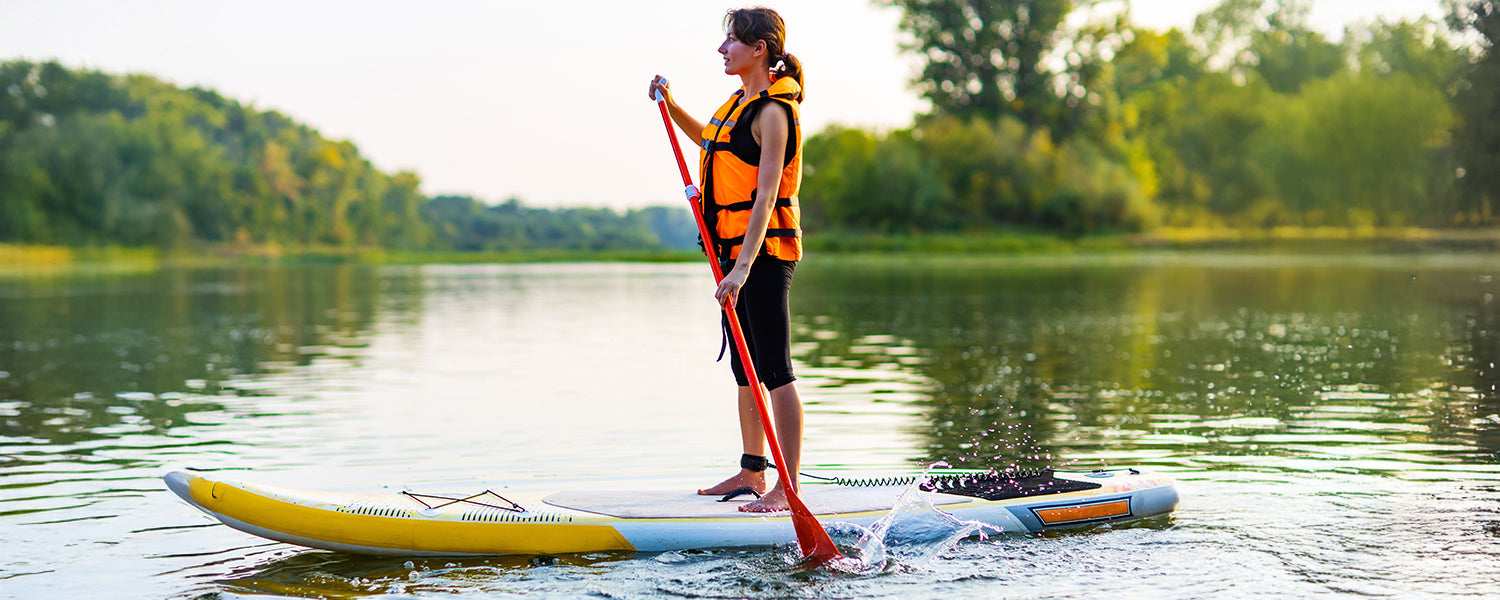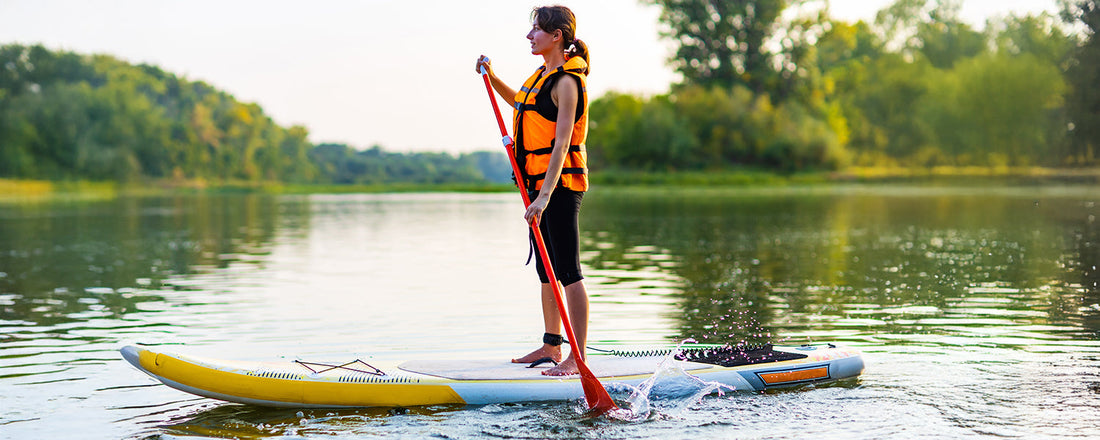Commonly known as a ‘life jacket’, a PFD (Portable Floatation Device) is an invaluable piece of safety equipment. Put simply, this is something that should be fitted to your body whenever participating in a water based sport. This is because all on-water activity has a certain level of risk, even despite how fun they can be!
If you’re one of the thousands of Australians that have taken up paddleboarding, we’re here to spell out the importance of wearing a PFD. We’ll also cover the regulations in each state to make sure that you’re well informed and ready to use your SUP in a safe way.
The Technology Behind Personal Flotation Devices
The first ever variation of what we now know as a PFD can be traced back to the cork lifejackets worn by naval personnel in the early 1800s. Over time, the designs and materials have changed, but the core purpose has remained the same. When the wearer enters a body of water, the PFD’s natural buoyancy technology allows it to float to the surface and prevent the wearer from submerging.
These days, PFDs are designed using advanced materials and technology that provide excellent buoyancy and support in the water. Some PFDs feature automatic inflation mechanisms that activate upon water immersion, while others require manual activation.
If you’re paddling in Australia, it's absolutely essential to select a PFD that meets Australian Standards–this is non negotiable.
How Do I Know the PFD is the Correct Size?
Of course, in order for a PFD to be effective, it must fit the individual wearing it. An ill-fitting PFD that’s too loose will slip off and render itself useless.
Selecting a PFD that fits properly is vital for both comfort and safety. A well-fitted PFD should be snug yet allow for free movement. To determine the correct size, refer to the manufacturer's sizing chart, which typically considers chest measurements and paddler weight.
As you try out different options, fasten all straps and buckles, then lift the shoulders; If it's the right fit, it should stay in place and not ride up over your chin or face. Adjustable straps can also help you achieve a more personalised fit that feels comfortable to you.
Understanding Lifejacket Levels
Certain international lifejackets meet Australian regulations. Look for those compliant with AS 4758, which offer improved buoyancy, new technology, better design, and increased reflectivity. Lifejackets display levels 50, 50S, 100, 150+, with some inflatables exceeding level 150. Always choose a lifejacket branded with AS 4758.
Manufacturers also recommend replacing lifejackets every ten years due to material deterioration in marine environments.
Level 100 or Higher
Provides enough flotation to keep your head above water but is not for water skiing, aquaplaning, or similar activities. Accepted standards include:
-
AS 4758 (Level 100, 150, or more)
-
ISO 12402-2, 12402-3, 12402-4
-
EN399-1993, EN396-1993, EN395-1993
-
UL1180, CAN/CGSB-65.11-M88, CAN/CGSB-65.15-M88
-
NZ5823:2001 Type 401
From 1 January 2025, AS 1512 lifejackets are no longer acceptable.
Inflatable Lifejackets (Level 100 or Higher)
Inflatable lifejackets are usually level 150+, using CO₂ for buoyancy, making them lightweight and comfortable. They inflate manually (by pulling a tab) or automatically when in water. Excess spray can accidentally trigger auto-inflation.
Not allowed for water skiing, aquaplaning, or personal watercraft. Children under 12 years or 40 kg can wear auto-inflating versions.
Inflatable lifejackets may need annual servicing, either DIY (per manufacturer’s guidelines) or professionally.
Level 50 Lifejackets
Offers less flotation than level 100, with front and back panels only. It won’t keep your head above water if you’re unconscious. Suitable for sports like water skiing, sailboarding, kiteboarding, and sailing dinghies. Must meet one of:
-
AS 4758 (Level 50)
-
ISO 12402-5
-
EN393-1993
From 1 January 2025, AS 1499 lifejackets are no longer acceptable.
Level 50S Lifejackets
Similar to Level 50, but does not meet Australian colour standards. Designed for high-speed water sports (e.g. water skiing, PWC use, sailboarding). Must meet:
-
AS 4758 (Level 50S)
Looking to take up paddleboarding? We supply a fantastic range of stand up paddle boards for sale, as well as lifejackets, clothing, and everything else you need to hit the water in style.
Exploring the Current Regulations in Each State
In Australia, PFD regulations for paddleboarding vary between different states and territories. With that being said, it’s very important to be aware of the specific requirements in your area to remain compliant and safe.
Victoria
In Victoria, wearing a lifejacket on a stand-up paddleboard is mandatory when you are more than 400 metres from the shore. However, it's recommended to wear a lifejacket at all times while on the water, regardless of your distance from the shore. Using a leg leash is also highly recommended to maintain a connection to your board if you fall off. (Source: Safe Transport Victoria)
New South Wales
According to the NSW State Government, “it's recommended that people using stand-up paddle boards (SUPs) wear a lifejacket. If this is not possible, it's recommended that you use a leg rope so you do not get separated from your board.”
There were also recent changes made to PFD Requirements for Kayaking in NSW, which you can read all about in our recent article!
Queensland
As of 1 December 2024, Queensland has updated its lifejacket laws. These laws require everyone to wear a functional PFD for small sail boats (funboats, lasers, herons, pedal boats, rafts (including inflatable rafts), rowboats (excluding those operated by Surf Life Saving Australia Clubs), and finally, both sea and surf kayaks.
Although there are no explicit regulations for SUPs, it's still highly recommended to wear a lifejacket, especially in open waters or challenging conditions. (Source: Maritime Safety Queensland)
South Australia
Following a run of fatal and life-threatening incidents, South Australia has taken a proactive response to protect the safety of residents throughout the state. This included a recent move to tighten regulations around the types of lifejackets that are deemed acceptable for use.
From 1 January 2025, any lifejackets used in SA must meet the Australian Standard (AS) 4758 (Source: Maritime Safety South Australia). If you live locally or you’re planning to paddleboard here in the near future, we recommend consulting with local maritime safety guidelines for the most current information.
Need new lifejackets? Explore our collection right here online!
Tasmania
Tasmanian regulations mandate that lifejackets be worn on vessels under six metres in length when underway. For SUPs, while not explicitly stated, wearing a PFD is a sensible precaution, especially in remote areas or adverse conditions.
For further information, we recommend checking the latest guidelines from Marine and Safety Tasmania.
Western Australia
In Western Australia, lifejacket laws require PFDs to be worn on certain vessels and in specific conditions. For paddleboarders, it's recommended to wear a lifejacket, particularly when venturing more than 400 metres from shore or in areas with strong currents. Consult the Department of Transport for detailed regulations.
Additional Tips for Safety and Stability
Although wearing a PFD is very important, it’s only one piece of the puzzle. Here are some additional tips for safety and stability while paddleboarding:
Foot Positioning
Your stance on the board significantly affects balance, so proper foot positioning is essential for stability. Place your feet shoulder-width apart, aligning them with the board’s handle, as this is the most stable point. Keep your knees slightly bent to absorb movement from waves or ripples in the water.
Distribute your weight evenly across both feet, avoiding putting too much pressure on your heels or toes.
Choosing the Right Board
Selecting the right paddleboard can make a huge difference in your experience on the water. Beginners should opt for a board with a wider deck and higher volume, as these features provide increased stability. All-around SUPs are an excellent choice for those still learning, as they perform well in various water conditions, from flat lakes to gentle coastal waves.
A board that’s too small or too advanced can make balancing much harder, slowing down your progress.
Paddling Technique
Mastering the correct paddling technique enhances control, efficiency, and stability on your board. Start by ensuring your paddle is the appropriate length—typically 15 to 25 centimetres taller than your height. Hold the paddle with one hand on the top grip and the other on the shaft, keeping a firm yet comfortable grip.
Engage your core muscles rather than relying solely on your arms, as this provides more power and balance. Make smooth, controlled strokes, keeping the paddle blade fully submerged and angled slightly forward.
Selecting the Right Location
Choosing the right paddling location can significantly impact your safety and enjoyment. For beginners, calm and protected waters such as lakes, bays, and slow-moving rivers are ideal starting points. These environments offer minimal wave action and fewer obstacles, making it easier to focus on technique.
Avoid areas with strong currents, heavy boat traffic, or unpredictable weather conditions until you have more experience. Starting in familiar, controlled environments allows you to build confidence before progressing to more challenging locations.
Maintaining Relaxed Knees
Keeping your knees relaxed and slightly bent is a fundamental technique for maintaining stability on a paddleboard. A stiff stance can make it difficult to adjust to small movements in the water, increasing the likelihood of losing balance. Bending your knees allows your body to absorb motion, similar to how a surfer rides a wave or a skier navigates rough terrain.
If you find yourself wobbling, try lowering your centre of gravity slightly by bending your knees more and engaging your core. This simple adjustment makes a huge difference in overall stability.
Focusing Ahead
Where you direct your gaze plays a crucial role in balance and stability. Many beginners instinctively look down at their feet or the board, but this can make it harder to maintain a steady stance. Instead, focus your eyes on a fixed point in the distance, such as the horizon or a stationary object ahead.
Keeping your head up and looking forward helps align your posture correctly, allowing for smoother and more controlled movements.
Stock Up on Safety Equipment with PaddleZone
Whether you’re interested in kayaking, canoeing, or standup paddleboarding, PaddleZone is the perfect place to pick up all the safety equipment you need. We stock everything from PFDs to paddle leashes, rescue throw bags, and much more.
If you live anywhere near Sydney or the Gold Coast, feel free to drop by one of our stores today! Otherwise, place an order online and we can ship it to any location in Australia. Happily paddling!



